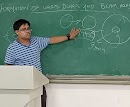The Insane Engineering of SpaceX’s Merlin Engines Part-2: Introduction to Turbopump
First of all, I wish all my beloved readers a very happy and prosperous new year 2022. I wish in this new year, we all can learn many new things and can apply those for the betterment of mankind.
Before reading this article, I will highly recommend you to read the part-1 article in this series of Insane engineering of SpaceX’s Merlin Engine for better understanding. In this article, I will be introducing you to the basic concept of Turbopumps used in cryogenic engines. In later articles, we can use this knowledge for understanding Merlin’s design and functionality.
So, let’s start…
Now you have a fuel
tank and propellants. But these two things alone aren’t enough for the
effective combustion in the combustion chamber to create a thrust greater than
the gravity and ultimately lift up the rocket. So, to solve this issue rocket
engineers developed a device named turbopump. Turbopump helps to send the
propellant to the combustion chamber at a high speed and effectively. The Merlin engines use LOX and RP-1 turbopump. It delivers about 10,000 horsepower or 7500 kilowatts of power with 36,000 revolutions per minute.
Now, the obvious
question may arise that, why we don’t use the normal electric pump that we use in
our home as it is easier and cheaper to manufacture?
The answer is, we don’t use them as
they would be bulky and also need a large amount of power supply in form of
batteries which in turn also increase the overall weight.
So, now that you know
the importance of turbopump, then let’s dig more into its technical aspects.
Turbopump mainly has two main components, a rotodynamic pump and a gas turbine.
In simple terms, a rotodynamic pump is a machine to pump fluid (here,
propellent) by using a rotating impeller.
Now, both the above
components are mounted together. Since the whole system has a gas turbine, so
we need gas to drive it. To achieve this, we have to circulate the liquid
hydrogen around the hot nozzle and combustion chamber of the rocket and pass
the resulting gaseous hydrogen to the turbine to drive it. This also helps to
cool the nozzle and combustion chamber whose temperature can reach up to 3000
degrees Celsius and cause material damage.
After the gas did its
job of driving the turbine, the gas is again sent back to the combustion chamber.
The rotating turbine then drives the impeller which helps to increase the flow
of liquid hydrogen or oxygen. This whole configuration is called an expander
cycle.
However, even after
using this configuration, we cannot pump the liquid hydrogen with the high speed
required to sustain enough trust for the effective thrust. This is because of the
simple property of gas. As we all know the more we heat a substance more it
expands and has greater kinetic energy. So, here to heat the liquid hydrogen
we use the thermal energy radiated from the hot nozzle and combustion chamber.
But the problem is that that heat is also not sufficient enough to drive the
turbine at the required speed to pump the liquid hydrogen for effective thrust.
So, to tackle this
problem, engineers have developed something known as Gas Generator Cycle. In
this method, a small portion of the liquid hydrogen is burned in a small
separated combustion chamber and then the resulting hot gases are used to drive
the gas turbine. The turbine then turns the impeller and it ensures high speed
of liquid propellent flow around the nozzle and ultimately to the main
combustion chamber of the engine.
 |
| Gas-Generator Cycle |
But this design is
inefficient as a small amount of exhaust gas is totally lost and results in
loss of potential fuel. Although there are various ways to increase the efficiency of the system like diverting the hot gas due to the hot nozzle to the
small combustion chamber and also diverting the exhaust which was getting lost
earlier to the main combustion chamber of the engine. This results in a half-burned
fuel-rich mixture that has both high temperature and pressure.
Also, one must remember that in this article I used liquid hydrogen (LH2) and oxygen (LOH) to explain to you the working of turbopumps, which is traditionally being used in various engines. But, in merlin engines, a combination of LOX and RP-1 is used.
The main challenge
with any cryogenic engine is to maintain specific oxygen to hydrogen ratio
which is also known as the propellant mixture ratio. This crucial job is totally
dependent on the effective design of the turbopump. Also, one of the main
challenges of the turbopump design is that in turbopumps the propellant flow rate
is controlled by a gas turbine which is also gets controlled by the propellant
combustion or hot propellant gas. If this design is achieved successfully then
one can finally manufacture a cryogenic engine. But in reality, it's not the
case. Only a handful of countries successfully manufactured and used this type
of engine.
In my next article, I will try to introduce you all to the different versions of Merlin engines with the specifications and problems of each of them. Once it is published, the link will be available in this article.
Thanks for Reading!!!













0 Comments